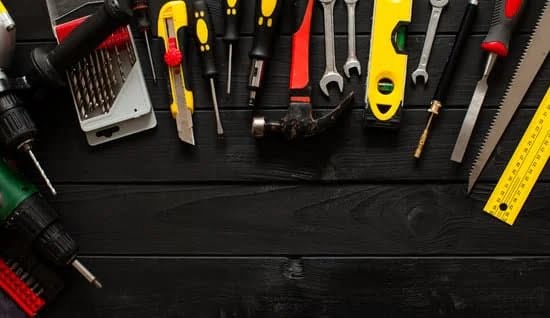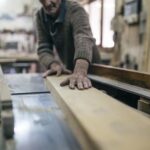When embarking on a painting project, it is crucial to understand the correct order of painting woodwork before walls for a flawless finish. Many homeowners often wonder about the sequence in which they should tackle these tasks, and this article aims to address this common question. By following a proper woodwork painting order, you can achieve a professional result and avoid potential issues down the line.
Painting woodwork before walls is vital because it sets the foundation for a successful painting project. This section will explain the importance of adhering to this order, dispelling any misconceptions that may exist. Understanding why it is necessary to paint woodwork before walls will not only lead to aesthetically pleasing results but also help ensure the longevity of your paint job.
Before diving into the step-by-step process of painting woodwork and walls, it is essential to gather all the necessary tools and materials for the job. Preparing your workspace adequately is crucial to ensure a smooth painting process. This article will provide tips on creating an organized and well-prepared area while highlighting the importance of protective measures for surrounding surfaces.
Stay tuned as we delve into evaluating the condition of your woodwork, sanding and priming techniques, protecting woodwork during wall painting, and achieving a professional finish in both areas. We will also explore key considerations when preparing walls for paint application after completing woodwork painting. Prepare yourself for expert advice, detailed instructions, and valuable recommendations throughout this comprehensive guide on how to properly paint your woodwork before tackling your walls.
Preparing the workspace
Preparing the workspace is an essential step before embarking on any painting project, especially when it comes to painting woodwork and walls. To ensure a smooth painting process and achieve a flawless finish, it is crucial to gather the necessary tools and materials beforehand.
Firstly, you will need basic tools such as paintbrushes, rollers, paint trays, and a stirring stick. When selecting paintbrushes, it is recommended to have both angled brushes for precision work on woodwork and larger brushes for covering larger wall surfaces. Rollers are great for efficiently covering large areas of both woodwork and walls. Additionally, having different sizes of rollers can help you reach tight corners and edges.
In terms of materials, high-quality paints for both woodwork and walls are crucial for achieving a professional finish. Depending on the type of surface you are working with – whether it’s bare wood or previously painted – you may require different types of paint. It is important to read the manufacturer’s instructions to select the appropriate paint for each surface.
Furthermore, gathering protective measures for surrounding surfaces is essential to avoid accidental spills or damage. Drop cloths or plastic sheets should be used to cover floors and furniture near the workspace, providing protection against splatters or paint drips. Painter’s tape should also be included in your toolkit to protect the edges of woodwork from unwanted paint application.
Creating a well-prepared workspace not only ensures efficiency during the painting process but also helps maintain cleanliness throughout the project. By having all the necessary tools and materials at hand before starting, you can focus on achieving a flawless finish without interruptions or delays.
Evaluating the condition of the woodwork
Identifying potential issues
Before painting woodwork, it is crucial to evaluate the condition of the surfaces to identify any underlying issues that may need attention. Inspect the woodwork thoroughly for cracks, holes, or peeling paint. These imperfections can affect the overall finish and longevity of the paint job if not addressed properly.
Cracks in the woodwork should be filled in using an appropriate wood filler. Ensure that all cracks are completely filled, and then smooth out the surface using sandpaper. Holes in the woodwork can be repaired using a similar technique, where a filler is applied to fill the hole and sanded down afterwards.
Peeling or flaking paint on the woodwork needs to be removed before proceeding with painting. Use a scraper or sandpaper to carefully remove any loose paint until you reach a stable base. This will prevent further peeling and ensure better adhesion for the new paint.
Techniques for repairing damaged woodwork
Once any issues have been identified, it is important to follow proper techniques for repairing damaged woodwork. Start by cleaning the surface of dust and debris using a damp cloth or sponge.
For larger cracks or holes, consider using wood putty instead of regular filler as it provides a more durable solution. Apply the putty with a putty knife and smooth it out as much as possible to achieve an even surface. Allow ample time for drying as per the manufacturer’s instructions before sanding.
For more extensive damages such as rotted or severely damaged sections of woodwork, it may be necessary to replace those components entirely. This ensures structural integrity and prevents problems from recurring after painting.
Emphasizing proper prepping of woodwork
Properly preparing the woodwork before painting is essential for achieving a flawless finish that will last longer. Once repairs are complete, make sure to thoroughly clean the surface to remove any dust, dirt or grease. This can be achieved by wiping it down with a mild detergent solution and rinsing with clean water.
Additionally, sanding the woodwork is crucial for creating a smooth surface that allows the paint to adhere properly. Use a fine-grit sandpaper to remove imperfections and create a slightly rough texture on the surface. Wipe away any residual dust after sanding.
Sanding and priming the woodwork
As part of the process of painting woodwork before walls, it is essential to properly sand and prime the woodwork. This step is crucial in creating a solid base for paint adhesion and ensuring a smooth and long-lasting finish. By following the right techniques for sanding and priming, you can achieve professional results and prevent potential issues such as bleed-through or an uneven paint finish.
Sanding the woodwork
Before applying any primer or paint, it is important to thoroughly sand the woodwork to remove imperfections and create a smooth surface. Start by using a medium-grit sandpaper (around 120-grit) to gently sand the wood along the grain. This will help remove any roughness or inconsistencies on the surface. Pay close attention to areas with peeling paint or cracks, as these may require additional sanding or repair.
After using the medium-grit sandpaper, switch to a finer-grit sandpaper (around 220-grit) for a final smoothing process. This will ensure that the woodwork surface is adequately prepared for primer application. Always remember to wipe away any dust or debris from sanding before moving on to priming.
Priming the woodwork
Once the woodwork has been sanded, it is time to apply a primer. The appropriate primer for woodwork should be specifically designed for use on bare wood surfaces and provide good adhesion. Before applying primer directly onto the surface, make sure to protect surrounding areas with drop cloths or painter’s tape.
Using a brush or roller, evenly apply an even coat of primer over the woodwork. Follow the manufacturer’s instructions regarding coverage and drying times. It is important not to rush this step in order to allow proper adhesion and sealing of the surface.
The benefits of using primer cannot be overstated when painting woodwork before walls. Primer helps seal porous surfaces like wood, improves paint adhesion, and provides a consistent base for the final coat of paint. Additionally, it can help prevent issues such as bleed-through from the wood or uneven paint finish. By taking the time to properly sand and prime the woodwork, you are setting the stage for a flawless and professional-looking finish.
By following these steps of sanding and priming, you can ensure that your woodwork is prepared correctly before moving on to painting the walls. This will result in a solid base for paint adhesion and will ultimately contribute to achieving a flawless and long-lasting finish throughout your entire painting project.
Taping and protecting woodwork
When it comes to painting woodwork before walls, one crucial step that should not be overlooked is properly taping and protecting the woodwork. This section will provide a step-by-step guide on how to safeguard the woodwork during wall painting, ensuring that no accidental paint splatters or spills ruin your freshly painted surfaces.
The Right Way to Apply Painter’s Tape
- Start by cleaning the woodwork thoroughly to remove any dust or debris that may interfere with tape adhesion.
- Use a high-quality painter’s tape that is specifically designed for delicate surfaces like woodwork.
- Begin at one end of the woodwork and carefully apply the painter’s tape along the edges where it meets the walls.
- Press down firmly on the tape to ensure proper adhesion, making sure there are no air bubbles or gaps.
- Continue applying the painter’s tape along all areas that need protection, such as baseboards, door frames, and window trim.
- Take extra care when taping around corners or curves to achieve clean lines.
- 7. To prevent paint from seeping underneath the tape, use a putty knife or your fingernail to press down along the edge of the tape.
Techniques for Protecting Woodwork
- Lay down drop cloths or plastic sheeting over floors, furniture, and any other nearby surfaces to protect them from accidental paint drips or splatters.
- For vertical woodwork such as window frames or door frames, consider using plastic sheeting secured with masking tape to create a protective barrier.
- Cover switch plates, outlets, and doorknobs with painter’s tape or plastic bags to keep them paint-free.
- If you’re painting walls with a roller, use an angled brush to cut in alongside taped-off woodwork before rolling on paint. This ensures that you have full coverage near the woodwork without touching it with the roller.
- When painting walls near woodwork, hold a small piece of cardboard or an index card against the woodwork as a shield to prevent accidental smudges.
Remember, properly taping and protecting your woodwork not only helps maintain its pristine condition but also saves you time and effort in cleaning up any accidental paint mishaps later on. By following these techniques, you can confidently proceed with painting your walls knowing that your woodwork is well-protected.
Painting the woodwork
Painting the woodwork is an essential step in achieving a professional finish for your home. By following a step-by-step guide, you can ensure that the process is smooth and results in a flawless outcome. Here is a detailed guide on how to paint woodwork like a pro:
- Selecting the ideal paint: Before you start painting, it’s important to choose the right type of paint for your woodwork. Consider factors such as durability, sheen level, and compatibility with the primer you’ll be using. For interior woodwork, latex or oil-based paints are commonly used. Satin or semi-gloss finishes work well for trim and baseboards.
- Choosing the appropriate tools: To achieve a professional finish, it’s crucial to select the right painting tools. Use high-quality brushes with fine bristles for better coverage and smooth application. A 2-inch angled brush works well for most woodwork surfaces. Additionally, consider using a small roller or foam brush for larger areas such as doors or cabinets.
- Preparing the woodwork: Before applying paint, make sure to prepare the woodwork properly. Start by cleaning the surface with mild soap and water to remove any dirt or grease buildup. If there are any imperfections such as cracks or holes, fill them with a suitable wood filler and sand it down until smooth.
- Applying the paint: Begin by cutting in along the edges of the woodwork using an angled brush, ensuring clean lines between the woodwork and walls. Then use long, even strokes to apply paint to larger areas. Work in small sections at a time to prevent drips or uneven coverage. Always follow the direction of the grain when painting wooden surfaces.
5.Two coats may be necessary depending on color opacity and desired coverage.The first coat should be applied evenly while making sure not to overload your brush with too much paint; this will help avoid drips and streaks. Allow the first coat to dry before applying a second coat for a smooth, professional finish.
| Steps |
|---|
| Selecting the ideal paint |
| Choosing the appropriate tools |
| Preparing the woodwork |
| Applying the paint |
| Second coat application (if necessary) |
By following these steps and paying attention to detail, you can achieve a professional finish when painting your woodwork. Remember to take your time, be patient, and ensure proper drying between coats for the best results.
Preparing the walls
Before diving into painting the walls, it is crucial to establish a suitable foundation to ensure a flawless finish. This section will discuss the necessity of completing woodwork painting before proceeding to the walls, address potential challenges and solutions when dealing with woodwork near wall surfaces, and explore techniques for properly cleaning and preparing walls for paint application.
Completing the woodwork painting before moving on to the walls is essential because it allows for a seamless transition and professional-looking outcome. When paint is applied to the woodwork first, any accidental drips or splatters can be easily covered up when painting the walls.
If you were to paint the walls first and then attempt to paint the woodwork, you would risk getting unwanted paint on your freshly painted walls, resulting in additional touch-ups or even having to repaint entire sections.
Dealing with woodwork near wall surfaces can present some challenges during preparation. One common issue is ensuring clean and sharp lines between the woodwork and walls. To achieve this, it is recommended to use painter’s tape along the edges of the woodwork before starting to paint the walls.
However, it is important to remove the tape while the paint is still wet so that it doesn’t peel off any fresh paint from both surfaces. Additionally, if there are any gaps between the woodwork and walls, they should be properly filled in with caulk or putty to create a smooth transition.
Properly cleaning and preparing your walls before painting is essential for achieving a long-lasting finish. Start by removing any dirt or dust from the surface using a soft cloth or sponge. For more stubborn stains or grease spots, use mild detergent mixed with water and gently scrub them away.
After cleaning, inspect your walls for any imperfections such as cracks or holes – these should be filled in with spackling compound and sanded down until smooth. Finally, give your walls a final wipe down to remove any leftover dust or residue, ensuring a clean surface for paint application.
By following these steps and properly preparing your walls after completing the woodwork painting, you will establish a suitable foundation for wall painting. This will result in a smooth and professional-looking finish that enhances the overall appearance of your space. Remember to take your time during the preparation process, as thoroughness is key to achieving the best results.
Painting the walls
After completing the painting of the woodwork, it is time to move on to painting the walls. This step is crucial in achieving a seamless transition from the woodwork to the walls and creating an aesthetically pleasing result. Here are some important considerations and techniques to ensure a flawless outcome.
1. Priming the walls: Before applying paint to the walls, it is important to prime them first. Priming helps create a smooth surface for paint adhesion and ensures an even color tone. Choose a primer that is suitable for your wall surface, whether it be drywall, plaster, or any other material. Apply the primer following the manufacturer’s instructions and allow sufficient drying time before proceeding with paint.
2. Choosing the right paint: Selecting the proper paint for your walls is essential for achieving a professional finish. Consider factors such as sheen (matte, eggshell, satin, or semi-gloss), durability, and washability. It’s also important to choose a color that complements your woodwork while considering your personal preferences and overall design scheme.
3. Proper painting techniques: When painting the walls, start by cutting in along edges near the woodwork using a brush or edging tool. This will help create clean lines between the wall and woodwork. Next, use a roller to apply paint in even strokes across each section of the wall. Work in small sections at a time to prevent drying lines or visible brushstrokes.
4. Blending colors: To achieve a seamless transition from woodwork to walls, it is important to blend the colors where they meet. This can be done by slightly overlapping paint onto the edge of the woodwork while maintaining a steady hand and consistent pressure on your brush or roller. Take your time during this step and ensure that there are no visible lines or uneven color variations.
By following these tips and techniques, you can achieve a flawless transition from woodwork to walls and create a visually pleasing finish. Remember to take your time, use the right tools, and pay attention to detail for the best results.
Final touches and recommendations
After completing the woodwork and wall painting process, there are a few final touches and recommendations to consider in order to ensure a truly finished and professional-looking result. First, it’s important to tackle any touch-ups or imperfections that may have appeared during the painting process. Take a step back and carefully inspect both the woodwork and walls, looking for any spots that might need a bit of extra attention.
For any areas that require touch-ups, make sure to have some extra paint on hand in the same color as what was previously used. Use a small brush or roller to carefully cover up any blemishes, taking care to blend the new paint seamlessly with the surrounding area. This attention to detail will go a long way in achieving a flawless finish.
Once all touch-ups have been made, it’s time to think about maintaining the newly painted woodwork and walls. Regular cleaning is essential in keeping them looking fresh and vibrant. Use a mild soap and water solution along with a soft cloth or sponge to gently wipe down surfaces as needed. Avoid using abrasive cleaners or harsh chemicals that could potentially damage the paint.
In addition to cleaning, consider implementing preventative measures to protect your newly painted surfaces. Place furniture pads on the bottom of chairs or tables to prevent scratches on woodwork, and use coasters under drinks to avoid water rings on painted surfaces. By taking these simple steps, you can help prolong the life and appearance of your freshly painted woodwork and walls.
As you wrap up your woodwork and wall painting project, don’t hesitate to share your experiences or ask any questions you may have about the process. Whether it’s troubleshooting an issue you encountered or seeking advice on color choices, there is a wealth of knowledge available from fellow DIY enthusiasts or professionals in this field. Sharing your experiences can also inspire others who are embarking on similar projects.
Remember, properly painting woodwork before walls is crucial for achieving a flawless finish. By following the steps outlined in this article, from gathering the necessary tools and materials to thoroughly preparing the woodwork, you can create a solid base for paint adhesion.
Taping and protecting the woodwork will ensure a clean transition to painting the walls, and taking the time for final touches and recommendations will result in a truly polished outcome. With these tips, you’ll be well on your way to transforming your space with beautifully painted woodwork and walls.

Hi everyone! I’m a woodworker and blogger, and this is my woodworking blog. In my blog, I share tips and tricks for woodworkers of all skill levels, as well as project ideas that you can try yourself.





